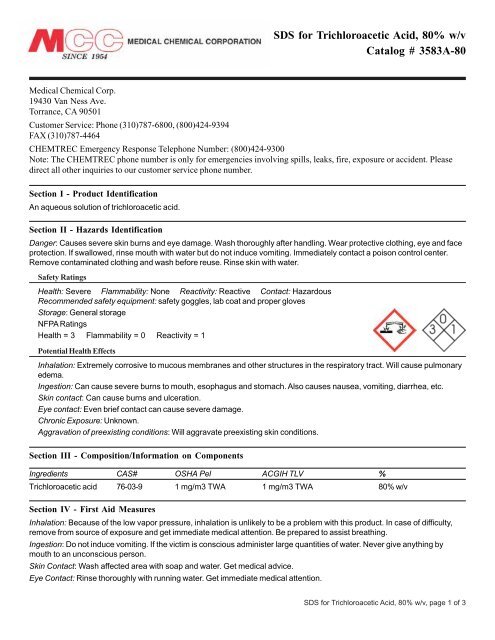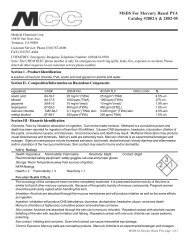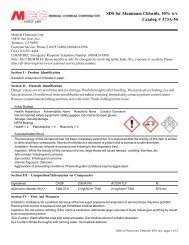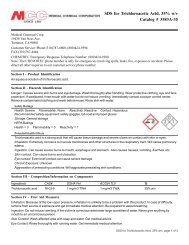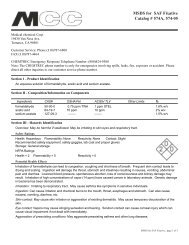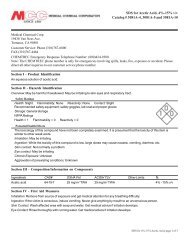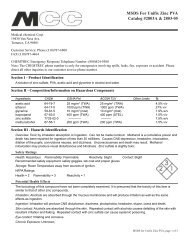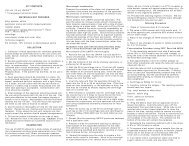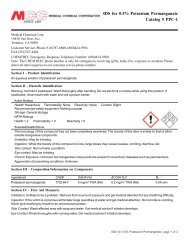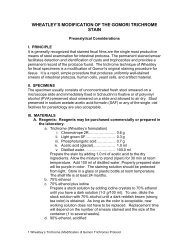SDS for Trichloroacetic Acid 80% w/v Catalog # 3583A-80
msds template - Medical Chemical Corporation
msds template - Medical Chemical Corporation
- No tags were found...
Create successful ePaper yourself
Turn your PDF publications into a flip-book with our unique Google optimized e-Paper software.
<strong>SDS</strong> <strong>for</strong> <strong>Trichloroacetic</strong> <strong>Acid</strong>, <strong><strong>80</strong>%</strong> w/v<br />
<strong>Catalog</strong> # <strong>3583A</strong>-<strong>80</strong><br />
Medical Chemical Corp.<br />
19430 Van Ness Ave.<br />
Torrance, CA 90501<br />
Customer Service: Phone (310)787-6<strong>80</strong>0, (<strong>80</strong>0)424-9394<br />
FAX (310)787-4464<br />
CHEMTREC Emergency Response Telephone Number: (<strong>80</strong>0)424-9300<br />
Note: The CHEMTREC phone number is only <strong>for</strong> emergencies involving spills, leaks, fire, exposure or accident. Please<br />
direct all other inquiries to our customer service phone number.<br />
Section I - Product Identification<br />
An aqueous solution of trichloroacetic acid.<br />
Section II - Hazards Identification<br />
Danger: Causes severe skin burns and eye damage. Wash thoroughly after handling. Wear protective clothing, eye and face<br />
protection. If swallowed, rinse mouth with water but do not induce vomiting. Immediately contact a poison control center.<br />
Remove contaminated clothing and wash be<strong>for</strong>e reuse. Rinse skin with water.<br />
Safety Ratings<br />
Health: Severe Flammability: None Reactivity: Reactive Contact: Hazardous<br />
Recommended safety equipment: safety goggles, lab coat and proper gloves<br />
Storage: General storage<br />
NFPA Ratings<br />
Health = 3 Flammability = 0 Reactivity = 1<br />
Potential Health Effects<br />
Inhalation: Extremely corrosive to mucous membranes and other structures in the respiratory tract. Will cause pulmonary<br />
edema.<br />
Ingestion: Can cause severe burns to mouth, esophagus and stomach. Also causes nausea, vomiting, diarrhea, etc.<br />
Skin contact: Can cause burns and ulceration.<br />
Eye contact: Even brief contact can cause severe damage.<br />
Chronic Exposure: Unknown.<br />
Aggravation of preexisting conditions: Will aggravate preexisting skin conditions.<br />
Section III - Composition/In<strong>for</strong>mation on Components<br />
Ingredients CAS# OSHA Pel ACGIH TLV %<br />
<strong>Trichloroacetic</strong> acid 76-03-9 1 mg/m3 TWA 1 mg/m3 TWA <strong><strong>80</strong>%</strong> w/v<br />
Section IV - First Aid Measures<br />
Inhalation: Because of the low vapor pressure, inhalation is unlikely to be a problem with this product. In case of difficulty,<br />
remove from source of exposure and get immediate medical attention. Be prepared to assist breathing.<br />
Ingestion: Do not induce vomiting. If the victim is conscious administer large quantities of water. Never give anything by<br />
mouth to an unconscious person.<br />
Skin Contact: Wash affected area with soap and water. Get medical advice.<br />
Eye Contact: Rinse thoroughly with running water. Get immediate medical attention.<br />
<strong>SDS</strong> <strong>for</strong> <strong>Trichloroacetic</strong> <strong>Acid</strong>, <strong><strong>80</strong>%</strong> w/v, page 1 of 3
Section V - Fire Fighting Measures<br />
Flash point: Not applicable.<br />
Flammable Limits: Not applicable.<br />
Fire: Not normally a fire Hazard.<br />
Explosion: Not Normally an explosion hazards.<br />
Fire Extinguishing Media: Any means suitable <strong>for</strong> surrounding fire.<br />
Special in<strong>for</strong>mation: Pyrolysis will release corrosive fumes.<br />
Section VI - Accidental Release Measures<br />
Absorb with a suitable absorbent and store in a suitable container <strong>for</strong> disposal.<br />
Section VII - Handling and Storage<br />
Store in a closed container, protected from freezing.<br />
Section VIII - Exposure Control/Personal Protection<br />
Airborne Exposure Limits: See section III.<br />
Ventilation System: Usually not required. When required, Refer to the ACGIH document, “Industrial Ventilation, a Manual of<br />
Recommended Practices” <strong>for</strong> details about ventilation.<br />
Personal Respirator: Usually not required. In case of emergency, or when exposure levels are unknown, use a positive<br />
pressure, full face piece, air supplied respirator.<br />
Skin protection: Protective gloves are recommended as part of good laboratory practice.<br />
Eye Protection: Laboratory safety goggles or similar products are recommended as part of good laboratory practice.<br />
Section IX - Physical and Chemical Properties<br />
Boiling Point: >102 o C<br />
Density: >1.2 g/ml<br />
Vapor pressure (mm Hg): 18 @ 20 o C Evaporation Rate (water = 1): 1<br />
Vapor Density (air = 1): 0.6<br />
Solubility: Infinitely miscible with water<br />
Appearance and Odor: A clear, colorless liquid. The solution will darken somewhat as it ages.<br />
Section X - Stability and Reactivity<br />
Stability: Freezes at low temperature.<br />
Hazardous Decomposition Products: Nothing unusual.<br />
Hazardous polymerization: Will not occur.<br />
Incompatibilities: Nothing unusual.<br />
Conditions to avoid: Excessive cold/heat and light.<br />
Section XI - Toxicological In<strong>for</strong>mation<br />
Extremely corrosive.<br />
Cancer lists<br />
Ingredient Known Carcinogenicity? Anticipated? IARC Category<br />
<strong>Trichloroacetic</strong> <strong>Acid</strong> No No 3<br />
Section XII - Ecological In<strong>for</strong>mation<br />
Environmental Fate: Biodegradable.<br />
Environmental Toxicity: Not likely to be toxic to marine life after neutralization.<br />
<strong>SDS</strong> <strong>for</strong> <strong>Trichloroacetic</strong> <strong>Acid</strong>, <strong><strong>80</strong>%</strong> w/v, page 2 of 3
Section XIII - Disposal Considerations<br />
Local governments usually restrict the pH of the effluent entering the sewer system to between pH 4 and 10. Also, strong<br />
acids will corrode metal plumbing. For these reasons, neutralization is recommended be<strong>for</strong>e flushing down the drain. Dispose<br />
of contents and container in accordance with all government regulations.<br />
Section XIV - Transportation In<strong>for</strong>mation<br />
DOT Shipping name: <strong>Trichloroacetic</strong> <strong>Acid</strong> Solution Hazard Class: 8 Packing Group: II<br />
DOT Hazard Label: Corrosive<br />
DOT Identification Number: UN2564<br />
Bottles smaller than 32 Fl. Oz. are eligible to be shipped under ORM-D or limited quantity exemptions [49 CFR section<br />
173.154(b) and 173.154(C)].<br />
Section XV - Regulatory In<strong>for</strong>mation<br />
Chemical Inventory Status<br />
Ingredient TSCA EC<br />
<strong>Trichloroacetic</strong> <strong>Acid</strong> Yes Yes<br />
Federal, State and International Regulations<br />
SARA 302 SARA 313 RCRA TSCA<br />
Ingredient RQ TPQ List Category 261.33 8(D) Ca. Prop 65<br />
<strong>Trichloroacetic</strong> <strong>Acid</strong> No No No No No No No<br />
Chemical Weapons Convention: No, TSCA 12(b): No, CDTA: No<br />
SARA 311/312: Acute: Yes, Chronic: Yes, Fire: No<br />
Section XVI - Other In<strong>for</strong>mation<br />
This in<strong>for</strong>mation is believed to be correct but is not waranteed as such, nor does it purport to be all inclusive.<br />
Revision Date: May 11, 2015<br />
<strong>SDS</strong> <strong>for</strong> <strong>Trichloroacetic</strong> <strong>Acid</strong>, <strong><strong>80</strong>%</strong> w/v, page 3 of 3


